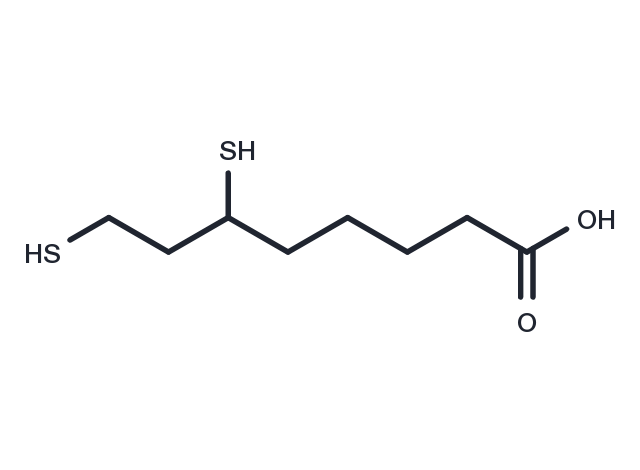Powder: -20°C for 3 years | In solvent: -80°C for 1 year


Dihydrolipoic acid (USAF XR-12), a dithiol-containing carboxylic acid, acts as a general antioxidant that is highly reactive against a variety of reactive oxygen species, including peroxynitirite, hydroxyl radicals, hydrogen peroxide, and hypochlorite, at concentrations ranging from 0.01-0.5 mM.

| Pack Size | Availability | Price/USD | Quantity |
|---|---|---|---|
| 25 mg | In stock | $ 33.00 |

| Description | Dihydrolipoic acid (USAF XR-12), a dithiol-containing carboxylic acid, acts as a general antioxidant that is highly reactive against a variety of reactive oxygen species, including peroxynitirite, hydroxyl radicals, hydrogen peroxide, and hypochlorite, at concentrations ranging from 0.01-0.5 mM. |
| Synonyms | Reduced thioctic acid, Reduced lipoic acid, DHLA, USAF XR-12, 6,8-Dihydrothioctic acid |
| Molecular Weight | 208.34 |
| Formula | C8H16O2S2 |
| CAS No. | 462-20-4 |
Powder: -20°C for 3 years | In solvent: -80°C for 1 year
DMSO: 50 mg/mL (239.99 mM)
You can also refer to dose conversion for different animals. More
bottom
Please see Inhibitor Handling Instructions for more frequently ask questions. Topics include: how to prepare stock solutions, how to store products, and cautions on cell-based assays & animal experiments, etc.
Dihydrolipoic acid 462-20-4 oxidation-reduction Antioxidant Reduced thioctic acid Lipopolysaccharide radical Reactive Oxygen Species centered anti-inflammatory oxygen Inhibitor inhibit Reduced lipoic acid DHLA Nrf2 ROS HO-1 USAF XR-12 ERK 6,8-Dihydrothioctic acid NLRP3 Depression Neuroinflammation inhibitor
